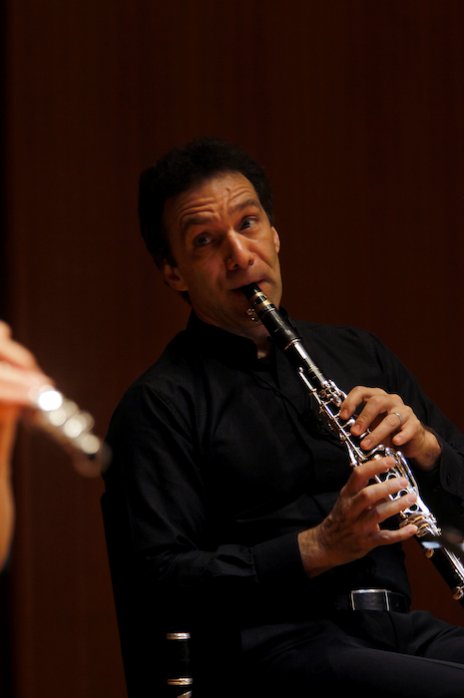Clarinetist Manasse is first among equals in St. Luke’s Mozart program

Clarinetist Jon Manasse performed Mozart’s Clarinet Quintet with Orchestra of St. Luke’s colleagues Tuesday night at Merkin Hall. Photo: Adam Stoltman
Not surprisingly, Mozart’s beloved Clarinet Quintet received top billing at Tuesday’s concert by the St. Luke’s Chamber Ensemble at Merkin Hall. The reason for the emphasis may originally have been to sell more tickets, but in the event the superb playing of clarinetist Jon Manasse justified it on artistic grounds as well.
Mozart composed the piece to exploit the abilities of his friend Anton Stadler, whose singing tone and blazing technique made him history’s first clarinet virtuoso. Since then, clarinetists have felt the heat of that spotlight in this piece, as they aspire to be latter-day Stadlers.
Perhaps the heat was relieved a little on Tuesday by the flexible and occasional nature of the ensemble, which consisted of players from the Orchestra of St. Luke’s who get together to perform chamber music. Typically, this Mozart work appears on programs by established string quartets, who invite an outsider into their charmed circle for one piece, almost like a concerto soloist at an orchestra concert.
On Tuesday the ethos was more of five colleagues exploring the music together. One was reminded of how much Mozart gave all the musicians to do, not just the clarinetist. First violinist Benjamin Bowman in particular led fine statements of the first movement’s themes by the strings and engaged the clarinetist in lively dialogue.
The other players—violinist Naoko Tanaka, violist David Cerruti, and cellist Daire FitzGerald—stepped up to their roles admirably as Mozart passed the melodic bounty around the group.
Still the first among equals, clarinetist Manasse gave a tutorial in full, creamy tone and brilliant staccato during the work’s first movement. Mozart marveled at Stadler’s ability to imitate the human voice, and on Tuesday Manasse showed similar gifts in the aria-like Larghetto, which was marred a bit by disagreements over intonation as the harmonies turned chromatic.
The minuet movement was enhanced by different treatments of the theme on its many returns, a nicely balanced first trio for the strings, and a swinging ländler beat in the second trio. The finale’s bouncy theme featured the evening’s first truly leggiero playing, and the ensuing five variations were strongly characterized, from Cerruti’s sad-sweet viola solo in the third variation to Bowman and Manasse’s hot arpeggio contest in the fourth. After the lush rubato of the fifth variation, an up-tempo coda brought cheers at the close.
Prior to the quintet, the somewhat stingy program included only one other piece, a Mozart novelty billed as “Grande Sestetto Concertante”—the title a publisher gave in 1808 to a posthumous, unattributed arrangement for string sextet of Mozart’s Sinfonia Concertante in E-flat major, K. 364.
In that pre-gramophone era, it wasn’t uncommon for publishers to issue reduced-instrumentation versions of symphonic or operatic hits for playing at home. In this case, Mozart’s original was a hybrid of symphony and duo concerto, featuring violin and viola solos with an orchestra including oboes and horns.
There was already a certain intimacy and chamber-music feeling in Mozart’s Sinfonia, and the uncredited 1808 arranger chose to go further in that direction by distributing the two soloists’ parts all around the string ensemble, phrase by phrase. Only the double bass was left out.
On Tuesday, that “concerto for almost everybody” didn’t quite achieve the illusion of an original composition for sextet. But enough was left of the original two-solo contest to produce a dialogue between Tanaka, playing first violin, and the first violist, Kaya Bryla. The latter got much the better of that matchup, with rich tone, heartfelt phrasing, and sure intonation.
A sextet including two violas, cello and double bass had the potential to shake the building with its low frequencies, and this one did. The foundation of that rich sound was the warm, tuned-in playing of double bassist John Feeney. Violinist Bowman, violist Cerruti, and especially cellist FitzGerald spoke out well in their soloistic turns.
The performance was a fair representation of the piece, with Mozart’s exquisite melodies and ingenious figurations coming through even in the curious arrangement. The pleasure of listening was that of watching highly accomplished players try out a new piece. The next stage, where the work itself occupies one’s mind more than the people playing it, wasn’t quite reached.
Further reflection might have produced more colors and textures in the string sound, and better leggiero playing would have relieved the constant sawing. But it’s unlikely the “Grande Sestetto” will ever seem like anything but a reduced version for Uncle Hans and his friends.
The program will be repeated 7:30 p.m. Wednesday at the Morgan Library and Museum and 2 p.m. Sunday at the Brooklyn Museum. oslmusic.org; 212-594-6100, Ext. 2.






